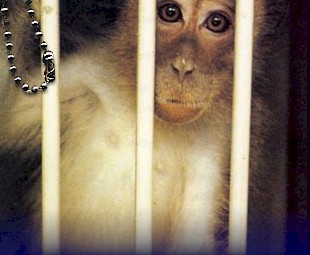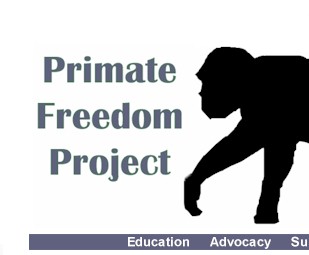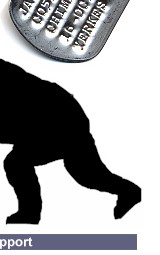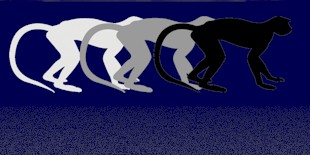J92476
was born on November 16, 1992. His mother was 87027, his father
was F79419. J92476 is a Macaca nemestrina, or pig-tailed macaque.
Pig-tailed macaques are native to the rain forests of southeast
Asia. Most of their day is spent foraging on the ground but they
are equally at home in the trees. They have evolved to fill a niche
of large vertical dimension as well as a large forest floor area.
Their natural behavior is to explore these large three-dimensional
highly complex environments in their search for food and novelty.
When not actively exploring and foraging individually, these monkeys
interact socially in groups and sleep near each other.
Macaques are generally intensely social and engage in much mutual
grooming. Social hierarchies and interpersonal and interfamily alliances
can be quite complex in larger groups and are often based on matrilineage,
as apparently is the case with pig-tail macaques. Exploiting a complex
environment and engaging in complex social relationships are characteristics
likely to be enhanced by, and likewise encourage, the development
of the complex minds and sharp intelligence seen in the macaques
and similar social primates.
A very large proportion of monkeys held in U.S. laboratories are
housed alone, in small, stainless steel cubicles with wire fronts.
J92476
was born a long way from his native homeland. He was born in Slave
Lake, Washington at a human prison remodeled into a monkey breeding
center and renamed the Primate Field Station, but now abandoned.
He is a slave; he is owned by the Washington Regional Primate Research
Center (WaRPRC), a part of the University of Washington. WaRPRC
is one of a number of very large primate research facilities in
the United States. Other facilities with very large populations
(generally 2000 or more) include the other seven RPRCs: Yerkes,
New England, Oregon, Tulane, Wisconsin, California, and Southwest.
Other large facilities include New Iberia, Manheimer, Wake Forest,
Poolesville, Labs of Virginia and handful of others. Contract labs
such a Bioqual and Covance also maintain large populations of monkeys
and are among the primary consumers of the twenty or so thousand
monkeys imported into the U.S. each year for research purposes.
The federal government pays to maintain primate breeding colonies
at a number of the RPRCs to provide many federally funded researchers
and labs with a steady supply of monkeys. Approximately sixty thousand
monkeys and apes are used each year in the U.S. The U.S. is the
world’s top consumer of primates.
On November 16, 1992, when J92476 was born, he weighed 0.485 kilograms,
not quite a pound. The notation on his Birth Record says, “Kid
looks good. Dam [mother] doing well.”
On the day he was born he was classified as “research reserve.”
On May 1, 1993, at the age of 51 months, he was reclassified as
“research.”
He was taken from his mother on July 28, 1993; the reason given
is “standard protocol.” He was about eight and a half
months old. Living at the Primate Field Station held advantages
for some of the monkeys living there, such as the relatively long
time J92476 was left with his mother. The Field Station had its
problems as well though. Monkeys who had been left exposed to the
elements died as a result. Others at the Field Station had died
of thirst. WaRPRC was even once fined for the conditions at the
Field Station, which is amazing considering what is done legally
to the animals on a daily basis.
On October 21, 1993, J92476 was assigned to a study being conducted
by William A. Morton titled “HIV-1/MN in M. nemistrina.”
William A. Morton is the director of WaRPRC.
Morton had twenty-one funded studies underway, a record perhaps,
as of the year 2000, to infect monkeys from a variety of macaque
species with HIV-1, HIV-2, a variety of SIVs, cloned SIVs, and lab-created
SHIVs.
Simian immuno virus, or SIV, is a retrovirus like HIV, but unlike
HIV, causes illness and death in some macaque species. SIV is not
harmful, generally, in its naturally occurring host species. It
causes illness only when experimentally, or accidentally, as in
the artificial mixed species colonies such as are maintained at
the large primate facilities, transferred to susceptible species.
Since the time SIV has been the subject of research, primate labs
have produced very many varieties of the virus. SIV has a propensity
to mutate as it passages through a new host. This has created a
wealth of opportunity for researchers to repeat experiments with
ever-new strains.
As research into SIV has progressed it seems to have become apparent
that what was being learned about SIV was informing researchers
about HIV in humans in only a general sense, SIV in a macaque is
a different disease in a different species. SIV in the susceptible
macaque species appears even to be a poor tool for understanding
why SIV is not harmful to all macaque species.
This frustration with being unable to apply what was being learned
about SIV to HIV led to the creation of SHIV, a sort of hybrid of
the two viruses created in the lab, and never before seen on the
planet. This new disease is deadly to some macaque species. Documentation
of the deaths of these monkeys has been no more productive with
regard to HIV, than has the earlier and ongoing experiments using
SIV.
Writing in a research abstract specifically investigating the various
responses to the viruses in different species, Morton wrote, “After
intravenous inoculation with 1,000 TCID of virus (equivalent to
100 animal infectious doses in M. nemestrina), M. fascicularis became
infected and showed depletion of circulating CD4+ cells similar
to M. nemestrina. The virus also infected M. mulatta, but at much
lower levels, and there was no evidence of pathogenesis.... A third
experiment ... [attempted to ascertain] the minimal infectious dose
for intrarectal inoculation. Two M. nemestrina were inoculated with
1000 TCID intrarectally; two others were inoculated with 10 TCID.
One of the pair inoculated at the higher dose became infected, and
neither of the pair inoculated at the lower dose was infected.”
From October 21, 1993, until February 2, 1995, J92476 was assigned
to four separate Morton studies on “HIV” but seems to
have escaped without life-threatening illness. As of January 2000,
J92476 had had blood drawn for research 104 times.
But in spite of this run of luck, getting to remain with his mother
for a while, escaping experimental death, his lot has been less
than comfortable and not without difficulty.
September 1, 1994: “Left arm caught above elbow. Sedated with
Ketamine and wire bars cut to release animal. Moderate edema of
forearm. Doesn’t require pressure bandage. Mild abrasions of
upper arm. No fractures. Observe for next 24 hrs.”
On December 7, 1994, J92476 was seen by veterinary staff again.
He was just over two years old:
“Animal prolapses rectum when stressed. [unclear] spontaneously.
No sign of traumatic injury or infection. Anal sphincter muscle
is stretched allowing rectum to prolapse. Purse string suture in
anus. Remove on Dec. 12. Monitor stool production.”
December 8: “Very stressed when being observed to the point
that it vomits. Suture intact. Very small pieces of feces under
cage. Animal may be having trouble defecating. If animal isn’t
passing normal amounts of stool on 12/9 – re-do suture.”
December 9: “Passing stools. Suture intact.”
December 10: “Passing normal stool. Suture intact.”
December 11: “Passing small amounts normal stool. Suture intact.”
December 12: “No stool in pan” [Then this entry is crossed
out and a note written above it: “Don just cleaned. Lots of
stool reportedly in pan prior to cleaning.” Entry continues:
“Small amount of dried feces on anus. Suture may be too tight
and preventing normal passing of feces. Ketamine sedation. Removed
suture. Anus is reddened and irritated. Leave suture out. If animal
prolapses return – re-suture or consider intra abdominal imbrication.”
December 13: “Normal stools. Sphincter muscle appears to be
holding. No need to replace suture. Observe for three days for signs
of recurring anal prolapse.”
December 14: “Stools normal. No rectal prolapse. No further
need to observe. Resolve case.”
On December 21, 1994, J92476 was again admitted for rectal prolapse.
The purse string suture procedure on his sphincter was repeated
and he was released from the veterinary unit on January 3, 1995.
Only two weeks later, on January 17, the following entry was made:
“During morning rounds observed animal looked dehydrated, lethargic
– had irritated eyes – checked Lixit [the automatic water
tube] – was not working – gave animal water in bowl and
small amounts of fruit – animal was eager to eat and drink
– continued to give animal small amounts of water and fruit
through out the day.”
January 18: Animal doing much better – hydration almost normal
– gave water/juice and fruit – doing well – continue
under observation and will offer extra fruit and fluids as needed
– animal is active and alert.”
On March 20, 1995, J92476 underwent surgery to turn him into one
of Dr. Morton’s living laboratories. He had a stomach catheter
implanted. The tube ran under his skin and exited through his back
for attachment to a tether.
Tethering monkeys in laboratories is common. Typically they are
placed in a vest or jacket that shields the tubes coming from their
bodies from their efforts to pull the tubes out. Monkeys on tethers
are always housed alone. This individual housing – essentially
a form of solitary confinement – is a known cause for such
severe mental stress that monkeys commonly develop self-mutilating
behaviors as a result.
March 27: “Animal inoculation performed. Experimental drug
or substance. HIV-2/287.” This was injected intravenously.
“Experimental procedure from 27-Mar-95 to 17-Jul-95: Administration
of medication: Gastric lavage performed. Experimental drug or substance.
Administration of antiviral drug D4T via gastrostomy tube.”
On March 20, a comment regarding another monkey (serial number obliterated)
being subjected to the same procedure was made: “Observed animal
in cage with possible skin erosion caused by tether jacket belt
being too tight – sedated animal – removed jacket –
animal had erosion site on abdomen of approx. 2 inches wide by 4
inches – shaved area, cleaned with Betadyne – applied
wound powder topically to area – animal seems thin, 100 mg
Iron 1cc B Complex – jacket was not replaced.”
On March 30, a swab of J92476’s rectum was taken.
On April 30, 1995, J92476 was reported to have diarrhea and found
to have a bacterial infection of the intestine.
July 17: The tether was disconnected and the catheter was removed.
It is worth noting that the two year period from January 18, 1995
until December 3, 1996 the daily records for J92476 are missing.
The information mentioned herein for that period was gleaned from
the Master History Report and various veterinary reports.
The first of a more detailed history begins again on November 25,
1996, nine days after J92476’s fourth birthday. He is reported
to have a “lacerated/crushed 2nd
digit\, Rt hand. The bone is reported to be broken. First aid is
given and amputation is suggested as a possible course of action.
November 26: “No amputation required.”
November 28: “Animal had removed bandage and injured thumb
of same hand. Significant abrasion on the back of his thumb.
December 1: “Sedated to change bandage. Wound fairly clean,
but no reduction in swelling from [unclear] injury, (Bone still
Broken!)” [The rest of the entry is unclear.]
December 2: “Agitated. Gave 0.25 cc Ketofen; sedated with Ketamine/Rompun.
Amputated digit to joint P-2; Sutured w/ 2-0 Dexon…”
December 3: “Animal eaten through bandage. Distal end swollen.
Applied wound powder and [unclear] gauze. (No Telfa pads).”
December 4: “Bandage removed and the animal has pulled out
the sutures.” The wounds were re-sutured and a new bandage
applied.
On December 5 they taped an egg carton on his hand in place of the
bandage.
J92476 is treated with antibiotics for the next few days. On December
10 an entry says that the bandage is now off and the wound looks
“ok.”
On December 11, it is noted that his finger is dry and that no bone
is exposed.
He was discharged on the 13th and a follow up entry on December
18 reports that his finger “has healed well.”
March 2, 1997: “Soles of both feet are dry, flaky – “athletes
foot” – in appearance. Hands are moist, normal –
no drying. After scrubbing… the pads are clean, but deep cracks
are inflamed. Monkey does not seem to favor feet. Walks normally.
Will watch.”
May 17, 1997: “Bld seen in cage & on left hand. Skin flap
on palm of left hand.” Treated with antibiotic and bandaged.
May 18: Part of the bandage has been torn away.
On May 23, J92476’s wound seems to be mostly healed.
There is another missing period of records.
June 20, 1998: “6:00 P.M. Sedated with .6 Ketamine. Prolapse.
Went back in after clean and lub [?]. Rectal prolapse of about 1
-- 3 inch sticking out. Flushed and cleaned w/ sodium chloride solution.
Lubed & placed back in. Watch for reoccurrence & diarrhea
next 24-48 hrs.”
On June 21 1998: A stool specimen is sent to the lab. The results
show he is infected with two types of Staphylococcus and E. coli,
but this is considered not to be related to his prolapsed rectum.
June 21: “Noted re-prolapesd this A.M. Called doctor on call.
Decided to put in ‘purse string’. To start on Ketofen
35 mg. BID IM. Sedated at 10 A.M. w/ 60 mg Ketamine & 30 mg
Atropine. 1 -- 3 inch colon sticking back out. Flushed and cleaned
w/ NaCl. Lubed & pushed back in. Placed 3-0 Dermalon suture
within anus. Remove suture in 3-4 days.
June 22: “Normal stool production / volume. Purse string intact
in rectal mucocutaneous junction. Patient irritated w/ suture &
self-examines rectum frequently on observation. Noted small amount
rectal mucosa protruding. Patient interested in grooming but also
paces in cage frequently.”
June 23: “Stools normal. Patient presented @ cage front for
grooming. Slight rectal prolapse of healthy rectal mucosa protruding.
Patient appears to have removed purse-string. Will update PI [principal
investigator, the researcher who has permission to experiment on
J92476] 6/24 after observation status.”
June 24: “No time for work-up today. ~1/2 inch protrusion rectal
mucosa persists w/ stools.”
June 25: “Rectal prolapse not evident today but patient still
self-examining. Normal stools.”
June 26: “1/2 inch prolapse rectal mucosa noted…”
June 27: “~1/2 rectal prolapse noted…”
June 28: “Continue Ketoprofen.”
June 29: “No signs of rectal prolapse. Patient pacing in cage
& approached for grooming.”
June 30: “Small rectal prolapse. Normal consistency and volume
of stools. Concerned about recurrence of prolapse in face of Ketaprofen
to reduce cellulites.”
July 1: Note prolapse on rounds ~ 3 pm. Prolapse protruding ~1 inch,
appears intact mucosa [with] no abrasions. Normal volume and consistency
of stools.
Late that day, J92476 underwent surgery for his prolapse rectum.
July 2: “Normal stool, animal somewhat depressed, but appetite
seems fine.”
July 3: “Animal alert, good appetite & normal stool.”
July 4: “No stool noted in A.M. Eating. Cont. Ketoprofen.”
July 5: “Removed purse string. No swelling evident.”
July 6: “Animal alert good appetite.”
J92476 seemed to be recovering for the next few days. He was eating
and reported as being alert. On the 8th he was reported to have
an increased pinkness to his face.
July 9: “Rectal prolapse ~1/2 inch noted. Stools continue to
be stable. Mucosa appears clean & no signs proctitis. No redness
to face.”
July 10: “Rectal prolapse 1 inch noted.” Again, J92476
was operated on for his anal prolapse. Another purse string suture
procedure was performed and more swaps sent to the lab for analysis.
[It is worth noting that the same people who are having so much
difficulty curing J92476’s prolapsing rectum are the very same
people claiming to be curing human disease by causing monkeys to
become ill in ways that seem to mimic human illnesses.]
The purse string holds for the next few days. On July 15, J92476
is reported to have soft stool and almost none on the 16th.
He is also reported to be starting to pull at the knot of the suture
in his anus.
On the 22nd someone finally sees the suture again and it seems to
be holding; his anus has not prolapsed.
For the rest of the month J92476 seems to be reasonably well. The
suture is not removed because he seems to have removed it himself.
One entry, from the 28th notes: “Normal-sized feces, purse
string suture gone. No signs rectal prolapse. Normal friendly mannerisms.”
The pinkness to his face seems to persist.
July 31: Normal mannerisms. Noted new rectal prolapse.
J92476 underwent another surgery for the prolapse. While anesthetized,
he also had a salve applied to his reddened elbows, stomach and
thighs. He also had his teeth cleaned.
August 11: “Patient relocated to cage #9 from #24 today per
research staff to help decrease outside social stressors & offer
slightly new environment.” The request to move J92476 to another
location had been made on July 24. The entry continues: “Patient
alert, appears much more uneasy in new environment [with] lots of
movement in cage. Purse string loose but intact.”
August 12: “Purse string intact. Normal behavior in cage.”
August 16: “Playful, opened cage to get bowl & he decided
to start helping himself around me to get out of the cage.”
August 17: “Purse string visible but grossly distended. Great
attitude & normal mannerisms.”
August 19: “Very friendly.”
August 27, 1998: “Aggressive movements towards neighboring
male #J94233 in cage #7. No signs of prolapse. Anesthetized @ 4
PM to reassess rectal tissue & ensure purse string gone. Nice
weight gain. Normal abdominal palpation. No signs suture material
& rectal mucosa not inflamed. Case closed.”
There is another lapse in the daily records.
April 16, 1999. J92476 is almost six and a half years old. “Noted
rectal prolapse (fresh) on observation. ~21 cm.” Another purse
string suture, another rash noted on his stomach.
On April 20 he was anesthetized again and examined. The suture was
intact, he had a slight fever, and they cleaned his teeth again.
On May 11 the suture was removed.
March 8, 2000: “patient needs canine teeth cutdowns redone.
All four canine teeth cutdown but upper canines (maxillary) are
not cut short enough & all canines have cracks in the composite.”
July 4, 2000: “Blood present in cage, mainly on the floor of
the cage. Minor trauma to [left] hand.” A monkey in an adjoining
cage is claimed to have bitten J92476. His hand is treated.
The final record we have
for J92476 is from August 25, 2000. He had the pulp removed from
his four canines, the teeth flattened further, and filled with a
composite material. He was placed on soft foods for 24 hours.
We also know that J92476 was transferred to Shiu-Lok Hu from William
Morton’s study. Hu is studying HIV. He writes on a federal
database: “Four of five Macaca nemestrina that were infected
with HIV-2287 and treated with d4T (Stavudine) remain in good health
3 1/2 years after drug therapy was discontinued (in July 1997),
despite persistent virus infection. The results of in vitro tests
suggest that the CD8+ cell population has a
role in maintaining the low levels of circulating virus and the
normal CD4+ cell numbers in the peripheral blood. One macaque did
develop depletion of the CD4+ cell population and was euthanatized.
The remaining macaques will continue to be monitored for clinical
status and progression to disease. Two macaques are assigned to
this project as normal controls.”
J92476 is one of the remaining four monkeys reported to be “in
good health.” This particular research grant, 5P51RR00166-390040,
expires on April 30, 2001. J92476’s future remains uncertain.
We wish him well.
Home Page | Our Mission | News
What Are Primate Freedom
Tags | Order Tag
Primate Research
Centers | Resources
|






